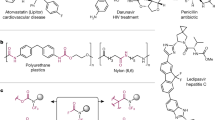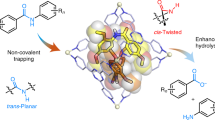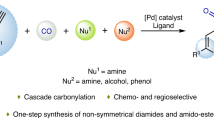Abstract
The amide functional group is one of the most fundamental motifs found in chemistry and biology, and it has been studied extensively for the past century1. Typical acyclic amides are planar. But the amide groups of bicyclic bridgehead lactams1,2 are highly twisted, and this distortion from planarity can dramatically affect the stability and reactivity of these amides; it also increases the basicity of the nitrogen so that it often behaves more like an amine than a typical planar amide. As a result, the structures and reactivity profiles of these ‘anti-Bredt’ amides3 differ significantly from those of planar amides. It is possible that this twisting phenomenon is not exclusive to cyclic systems—non-planarity may also be a critical biological design element that leads to amide ground-state destabilization and alters the reactivity, selectivity and mechanism of various protein and enzymatic processes (such as amide hydrolysis1,4,5,6,7,8,9,10). The intriguing qualities of these twisted amides were first recognized in 1938 (ref. 11), wherein one of the simplest families was introduced—molecules containing the 1-azabicyclo[2.2.2]octan-2-one system. But the parent member of this group, 2-quinuclidone (molecule 1 in this paper), has not yet been unambiguously synthesized. Here, we report the chemical synthesis, isolation and full characterization of the HBF4 salt of 1. Critical to the success of the synthesis and isolation was the decision to generate 1 by a route other than classical amide bond formation. We anticipate that these results will provide a greater understanding of the properties of amide bonds.
This is a preview of subscription content, access via your institution
Access options
Subscribe to this journal
Receive 51 print issues and online access
$199.00 per year
only $3.90 per issue
Buy this article
- Purchase on Springer Link
- Instant access to full article PDF
Prices may be subject to local taxes which are calculated during checkout



Similar content being viewed by others
References
Greenberg, A., Breneman, C. M. & Liebman, J. F. The Amide Linkage: Selected Structural Aspects in Chemistry, Biochemistry, and Materials Science (Wiley, New York, 2000)
Greenberg, A. Twisted bridgehead bicyclic lactams. Mol. Struct. Energetics 7, 139–178 (1988)
Bredt, J. Über sterische Hindering in Brückenringen (Bredtsche regel) und über die meso-trans-Stellung in kondensierten Ringsystemen des Hexamethylens. Liebigs Ann. Chem. 437, 1–13 (1924)
Mujika, J. I., Mercero, J. M. & Lopez, X. Water-promoted hydrolysis of a highly twisted amide: rate acceleration caused by the twist of the amide bond. J. Am. Chem. Soc. 127, 4445–4453 (2005)
Romanelli, A., Shekhtman, A., Cowburn, D. & Muir, T. W. Semisynthesis of a segmental isotopically labeled protein splicing precursor: NMR evidence for an unusual peptide bond at the N-extein-intein junction. Proc. Natl Acad. Sci. USA 101, 6397–6402 (2004)
Poland, B. W., Xu, M. Q. & Quiocho, F. A. Structural insights into the protein splicing mechanism of PI-SceI. J. Biol. Chem. 275, 16408–16413 (2000)
Brown, R. S., Bennet, A. J. & Slebocka-Tilk, H. Recent perspectives concerning the mechanism of H3O+- and hydroxide-promoted amide hydrolysis. Acc. Chem. Res. 25, 481–488 (1992)
Liu, J., Albers, M. W., Chen, C. M., Schreiber, S. L. & Walsh, C. T. Cloning, expression, and purification of human cyclophilin in Escherichia coli and assessment of the catalytic role of cysteines by site-directed mutagenesis. Proc. Natl Acad. Sci. USA 87, 2304–2308 (1990)
Harrison, R. K. & Stein, R. L. Mechanistic studies of peptidyl prolyl cis-trans isomerase: evidence for catalysis by distortion. Biochemistry 29, 1684–1689 (1990)
Mock, W. L. Torsional-strain considerations in enzymology: Some applications to proteases and ensuing mechanistic consequences. Bioorg. Chem. 5, 403–414 (1976)
Lukeš, R. Sur une nouvelle application de la régle de Bredt. Coll. Czech. Chem. Commun. 10, 148–152 (1938)
Johnson, J. R., Woodward, R. B. & Robinson, R. The constitution of the penicillins. In The Chemistry of Penicillin (eds Clark, H. T., Johnson, J. R. & Robinson, R.) 440–454 (Princeton Univ. Press, Princeton, 1949)
Wasserman, H. H. Profile and scientific contributions of Professor R. B. Woodward. Heterocycles 7, 1–15 (1977)
Yakhontov, L. N. & Rubsitov, M. V. The synthesis of quinuclidone-2. J. Gen. Chem. USSR 27, 83–87 (1957)
Pracejus, H., Kehlen, M., Kehlen, H. & Matschiner, H. Neues zur sterischen Mesomeriehhinderung bei Lactamen vom typ des α-Chinuclidons. Tetrahedron 21, 2257–2270 (1965)
Levkoeva, E. I., Nikitskaya, E. S. & Yakhontov, L. N. Reactions of 2-quinuclidones with and without scission of C–N bonds. Dokl. Akad. Nauk SSSR 192, 342–345 (1970)
Greenberg, A., Wu, G., Tsai, J.-C. & Chiu, Y.-Y. Improved synthesis of 6,6,7,7-tetramethyl-1-azabicyclo[2.2.2]octan-2-one and its stability toward base-induced methanolysis. Struct. Chem. 4, 127–129 (1993)
Boivin, J., Gaudin, D., Labrecque, D. & Jankowski, K. Gif oxidation of some alicyclic amines. Tetrahedr. Lett. 31, 2281–2282 (1990)
Greenberg, A., Moore, D. T. & DuBois, T. D. Small and medium-sized bridgehead bicyclic lactams: a systematic ab initio molecular orbital study. J. Am. Chem. Soc. 118, 8658–8668 (1996)
Blackburn, G. M., Skaife, C. J. & Kay, I. T. Strain effects in acyl transfer reactions. Part 5. The kinetics of hydrolysis of benzoquinuclidin-2-one: a torsionally-distorted amide. J. Chem. Res. (Miniprint) 3650–3669 (1980)
Bennet, A. J. et al. Relationship between amidic distortion and ease of hydrolysis in base. If amidic resonance does not exist, then what accounts for the accelerated hydrolysis of distorted amides? J. Am. Chem. Soc. 112, 6383–6385 (1990)
Wang, Q. P., Bennet, A. J., Brown, R. S. & Santarsiero, B. D. Distorted amides as models for activated peptide N–C = O units. 2. The synthesis, hydrolytic profile, and molecular structure of 3,4-dihydro-2-oxo-1,4-propanoquinoline. Can. J. Chem. 68, 1732–1739 (1990)
Buchanan, G. L. et al. Conformational study of the 1-azabicyclo[3.3.1]nonan-2-one system. Molecular-mechanics calculations and X-ray structure of 5-phenyl-1-azabicyclo[3.3.1]nonan-2-one. J. Chem. Soc. Perkin Trans. 2, 1709–1712 (1983)
Kirby, A. J., Komarov, I. V., Wothers, P. D. & Feeder, N. The most twisted amide: structure and reactions. Angew. Chem. Int. Edn Engl. 37, 785–786 (1998)
Greenberg, A. & Venanzi, C. A. Structures and energetics of two bridgehead lactams and their N- and O-protonated forms: an ab initio molecular orbital study. J. Am. Chem. Soc. 115, 6951–6957 (1993)
Williams, R. M. & Lee, B. H. Synthesis of a 1,3-bridged β-lactam: a novel, anti-Bredt β-lactam. J. Am. Chem. Soc. 108, 6431–6433 (1986)
Aubé, J. & Milligan, G. L. Intramolecular Schmidt reaction of alkyl azides. J. Am. Chem. Soc. 113, 8965–8966 (1991)
Lei, Y., Wrobleski, A. D., Golden, J. E., Powell, D. R. & Aubé, J. Facile C-N cleavage in a series of bridged lactams. J. Am. Chem. Soc. 127, 4552–4553 (2005)
Dunitz, J. D. & Winkler, F. K. Amide group deformation in medium-ring lactams. Acta Crystallogr. B31, 251–263 (1975)
Wiberg, K. B. & Laidig, K. E. Barriers to rotation adjacent to double bonds. 3. The C–O barrier in formic acid, methyl formate, acetic acid, and methyl acetate. The origin of ester and amide “resonance”. J. Am. Chem. Soc. 109, 5935–5943 (1987)
Acknowledgements
We thank H. H. Wasserman, E. J. Corey, and N. J. Leonard for discussions. We thank Ono Pharmaceutical Co. Ltd (for a postdoctoral fellowship to K.T.), the Research Corporation, the Camille and Henry Dreyfus Foundation, Merck, Pfizer, Lilly, Amgen and Bristol-Myers Squibb for financial support. We also thank M. W. Day and L. M. Henling for their X-ray crystallographic expertise.
Author information
Authors and Affiliations
Corresponding author
Ethics declarations
Competing interests
Reprints and permissions information is available at npg.nature.com/reprintsandpermissions. Crystallographic data have been deposited at the CCDC (12 Union Road, Cambridge CB2 1EZ, UK) and copies can be obtained on request, free of charge, by quoting the publication citation and the deposition number 296767. The authors declare no competing financial interests.
Supplementary information
Supplementary Notes
This file provides the full experimental details for the preparation of all new compounds and their characterization (PDF 1376 kb)
Supplementary Data
This file provides the X-ray data for 1•HBF4. (PDF 34 kb)
Rights and permissions
About this article
Cite this article
Tani, K., Stoltz, B. Synthesis and structural analysis of 2-quinuclidonium tetrafluoroborate. Nature 441, 731–734 (2006). https://doi.org/10.1038/nature04842
Received:
Accepted:
Issue Date:
DOI: https://doi.org/10.1038/nature04842
This article is cited by
-
An intramolecular coupling approach to alkyl bioisosteres for the synthesis of multisubstituted bicycloalkyl boronates
Nature Chemistry (2021)
-
Enhanced reactivity of twisted amides inside a molecular cage
Nature Chemistry (2020)
-
Nickel-Catalyzed Esterification of Amides Under Mild Conditions
Catalysis Letters (2020)
-
Amide nitrogen pyramidalization changes lactam amide spinning
Nature Communications (2019)
-
Highly selective transition-metal-free transamidation of amides and amidation of esters at room temperature
Nature Communications (2018)
Comments
By submitting a comment you agree to abide by our Terms and Community Guidelines. If you find something abusive or that does not comply with our terms or guidelines please flag it as inappropriate.



